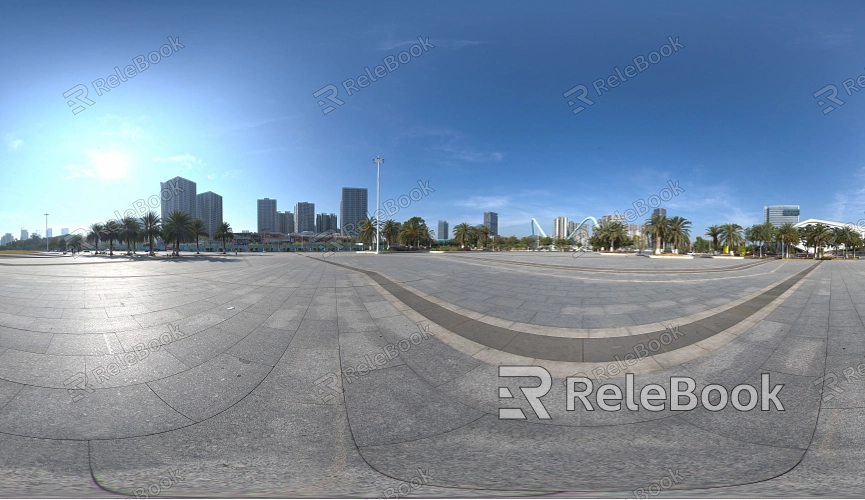What is the HDR Black Point
HDR images are widely used in gaming effects, architectural visualization, and interior design to create ultra-realistic textures for backgrounds. However, when rendering with these images, you might occasionally encounter an issue known as the "black point." These black points can disrupt the overall visual quality, especially in scenes where highlights and shadows play a crucial role. This article will explore the causes of HDR black points, the scenarios where they commonly appear, and how to address them in 3D design software, ultimately helping you enhance the quality of your work.

1. Understanding the HDR Black Point: Definition and Causes
Before diving into solutions, it's essential to understand what HDR black points are and why they occur.
Definition of HDR Black Point: An HDR black point refers to the appearance of unnatural black spots or shadows in certain areas of an image during HDR rendering. These black points are typically caused by errors in lighting calculations or defects in image processing.
Causes: Several factors can contribute to the formation of HDR black points, including improper lighting settings, errors in texture mapping, and calculation inaccuracies in the rendering engine when processing HDR images. This phenomenon is particularly likely to occur in high dynamic range scenes.
2. Common Scenarios Where HDR Black Points Appear
Recognizing the scenarios where HDR black points are likely to appear can help designers prevent or quickly identify the issue.
High Contrast Lighting: In scenes with strong contrasts between light and dark areas, HDR technology sometimes struggles to correctly handle extreme brightness levels, leading to the emergence of black points. For example, when a scene contains both very bright light sources and deep shadows, ray tracing algorithms might falter.
Complex Material Applications: When working with complex materials, especially those with high gloss or reflective properties, HDR rendering might produce black points. This is because these materials require more precise calculations of light reflection and refraction, and any miscalculation can result in issues.
3. Identifying HDR Black Points in 3D Software
Different 3D design software provides various methods to identify and address HDR black points.
Real-Time Previews: Many modern 3D software tools, such as Blender, 3ds Max, and Maya, offer real-time preview capabilities, enabling designers to spot potential issues before rendering. If you notice unnatural black spots during a preview, they may indicate HDR black points.
Adjusting Render Settings: Once you've identified HDR black points, you can try adjusting the render settings to fix the issue. Common solutions include increasing the number of ray tracing samples, adjusting exposure values, or changing the position of light sources.

4. Solutions to HDR Black Points
After identifying HDR black points, the next step is to find suitable solutions to ensure the final image quality.
Optimize Lighting Settings: Adjusting the lighting setup in your scene is a key step in resolving HDR black points. By reducing the intensity of light sources or increasing the proportion of indirect lighting, you can effectively minimize the occurrence of black points.
Increase Rendering Precision: Enhancing the precision of your render settings, such as by increasing the number of ray tracing samples or raising the rendering resolution, can significantly reduce the number of HDR black points. While this may increase render times, the improvement in image quality is often worth it.
Material Adjustments: For complex materials that cause black points, designers can try adjusting their reflectivity or glossiness, or even switch to a different material model, to reduce the likelihood of black points appearing.
5. Practical Application and Prevention in Projects
To avoid the impact of HDR black points on your final project, designers should take preventive measures during the design process.
Early Detection: During the early stages of a project, use low-resolution test renders and real-time previews to detect HDR black points as soon as possible. This not only saves time but also prevents issues that may be harder to fix later during final rendering.
Thoughtful Light Planning: In scene design, plan the placement and intensity of light sources carefully, avoiding extreme lighting contrasts. This can effectively reduce the occurrence of HDR black points.
6. The Future of HDR Black Points
As 3D modeling and rendering technologies continue to advance, the issue of HDR black points is likely to see better resolutions in the future.
Software Optimization: 3D design software developers are continuously refining HDR rendering algorithms to reduce the occurrence of black points. Future software versions may offer more intelligent detection and repair tools, making it easier for designers to manage this issue.
Enhanced Hardware Support: With the improvement of hardware performance, designers will be able to render at higher precision levels, thereby reducing the generation of HDR black points. This will make high-quality HDR rendering more accessible.
HDR black points are a potential challenge in 3D modeling and rendering, but with careful prevention and adjustments, their impact on the final product can be effectively minimized. If you're looking to further enhance your project quality or access more HDR image resources, Relebook offers a great platform. Whether you need high-quality HDR images or professional 3D models, Relebook can help you achieve better results in your projects.

